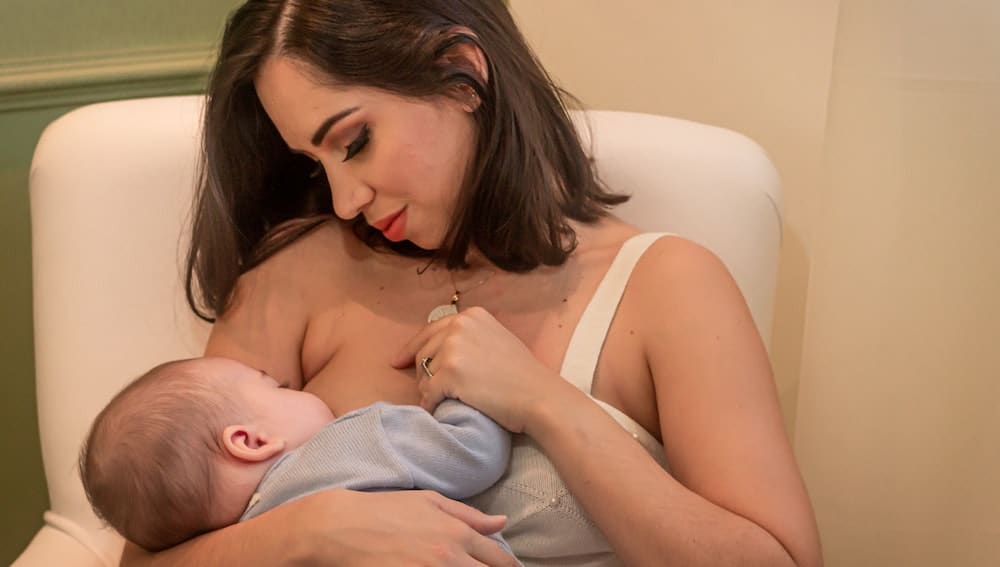Breastfeeding is an essential part of a baby’s growth and development, and new mothers often have many questions about how to do it properly. One question that frequently comes up is whether it’s safe to breastfeed while the baby is swaddled.
Swaddling is a common practice that involves wrapping a baby snugly in a blanket to help them feel secure and calm. However, some mothers may wonder if swaddling could interfere with breastfeeding or cause discomfort for their baby.
Understanding Swaddling Swaddling is a technique that has been used for centuries to help soothe fussy babies and promote better sleep. When done correctly, swaddling can help babies feel secure and calm, which can lead to longer periods of restful sleep.
However, it’s important to understand how swaddling works and how to do it safely to avoid any potential risks or complications.
The Relationship Between Swaddling and Breastfeeding While swaddling can be a helpful technique for calming a fussy baby and promoting better sleep, it’s important to understand how it can affect breastfeeding.
Some mothers may worry that swaddling could interfere with their baby’s ability to breastfeed effectively or cause discomfort. However, with the right techniques and safety measures in place, it’s possible to breastfeed while the baby is swaddled without any issues.
Key Takeaways
- Swaddling is a common technique used to soothe fussy babies and promote better sleep.
- Swaddling can be done safely with the right techniques and safety measures in place.
- Breastfeeding while the baby is swaddled is possible and can be done effectively with some practice and patience.
Understanding Swaddling
Swaddling is a technique used to wrap a newborn baby snugly in a blanket or cloth. It is believed to help babies feel secure and calm, as it mimics the feeling of being in the womb.
Swaddling can also prevent a baby from being disturbed by their own startle reflex, which can cause them to wake up suddenly.
To swaddle a baby, the first step is to lay the blanket on a flat surface in a diamond shape, with one corner pointing towards the top. Then, fold down the top corner, leaving enough space for the baby’s head to peek out.
Next, place the baby on their back in the center of the blanket, with their head above the folded corner. Take the left corner of the blanket and wrap it over the baby’s body, tucking it snugly under their back.
Then, take the bottom corner of the blanket and bring it up over the baby’s feet, tucking it in at the chest. Finally, take the right corner of the blanket and wrap it over the baby’s body, tucking it in at the back.
There are different types of swaddling blankets available, including those made of muslin, flannel, and cotton. Some swaddles are designed to be weighted, which can provide additional comfort and security for the baby.
It is important to choose a swaddle that is made of breathable fabric and is not too tight around the baby’s chest or hips, as this can interfere with their breathing and hip development.
While swaddling can be a helpful technique for soothing a fussy baby, it is important to remember that not all babies enjoy being swaddled.
It is also important to stop swaddling once the baby starts to show signs of rolling over, as this can be a suffocation risk. Parents should always follow safe sleep guidelines and consult with a healthcare provider if they have any concerns about swaddling their baby.
More about swaddling: How Tight Should a Swaddle Be
Breastfeeding Basics
Breastfeeding is a natural way to feed a baby and provides many benefits for both the baby and mother. It is important to understand the basics of breastfeeding to ensure a successful and comfortable nursing experience.
One of the key elements of breastfeeding is the latch. A proper latch allows the baby to effectively remove milk from the breast and helps prevent nipple soreness. A lactation consultant can provide guidance on achieving a good latch.
Another important aspect of breastfeeding is the letdown reflex. This is when milk is released from the breast in response to the baby’s sucking. It is important to be relaxed and comfortable during nursing sessions to encourage letdown.
Milk supply is another consideration for breastfeeding mothers. It is important to nurse frequently to maintain a healthy milk supply. If there are concerns about milk supply, a lactation consultant can provide guidance on increasing milk production.
Breastfeeding while swaddled can be a comfortable and convenient option for both the baby and mother. However, it is important to ensure that the baby’s head and neck are supported and that there is no pressure on the breast.
Overall, breastfeeding provides many benefits for both the baby and mother. With the right support and knowledge, it can be a rewarding and enjoyable experience.
The Relationship Between Swaddling and Breastfeeding
Swaddling is a common practice used by many caregivers to help soothe and calm newborn babies. It involves wrapping the baby snugly in a blanket or other cloth, with their arms and hands tucked in close to their body.
While swaddling can provide comfort and a sense of security for babies, some caregivers may wonder if it is safe or appropriate to breastfeed while the baby is swaddled.
Experts generally agree that it is safe to breastfeed a swaddled baby, as long as certain precautions are taken. For example, caregivers should ensure that the baby is not overheating, as swaddling can trap heat close to the baby’s body.
It is also important to ensure that the baby’s head and neck are well-supported and that they are positioned correctly for breastfeeding.
Swaddling can offer several benefits for breastfeeding, particularly for babies who have difficulty latching on or staying latched during feeding. When a baby is swaddled, their arms and hands are kept still, which can help them focus on feeding and prevent distractions or discomfort.
Swaddling can also help to keep the baby’s body in a comfortable and stable position, which can make it easier for them to feed for longer periods of time.
However, there are also some potential risks and challenges associated with breastfeeding while a baby is swaddled. For example, some babies may find swaddling uncomfortable or feel restricted by the blanket, which can make it difficult for them to feed effectively.
Additionally, some caregivers may find it challenging to position the baby correctly for breastfeeding while they are swaddled.
In general, the decision to breastfeed a swaddled baby should be based on the individual needs and preferences of the baby and caregiver. While swaddling can offer some benefits for breastfeeding, it is important to ensure that the baby is comfortable and safe at all times.
Caregivers should also be aware of the potential challenges associated with breastfeeding while the baby is swaddled and be prepared to adjust their approach as needed.
Safe Sleep Practices
When it comes to safe sleep practices, it is important to follow the guidelines provided by the American Academy of Pediatrics (AAP). This includes placing the baby to sleep on their back on a firm and flat surface, such as a crib or bassinet, without any soft objects or loose bedding.
Swaddling can be a helpful technique to soothe a baby and promote better sleep, but it is important to do it safely. The AAP recommends using a swaddle that allows for hip movement and breathing, and to stop swaddling once the baby shows signs of rolling over.
Using a sleep sack instead of loose blankets can also help reduce the risk of Sudden Infant Death Syndrome (SIDS). Sleep sacks provide a safe and cozy environment for the baby without the risk of suffocation or overheating.
It is important to avoid placing the baby to sleep with any objects that could potentially cover their face or obstruct their breathing, such as stuffed animals or pillows. Additionally, it is recommended to avoid letting the baby fall asleep in a car seat or swing, as this can increase the risk of SIDS.
Parents should also be aware of the startle reflex and how it can affect the baby’s sleep. Swaddling or using a sleep sack can help reduce the startle reflex and promote better sleep.
Overall, following safe sleep practices is crucial for the health and well-being of the baby. By following the guidelines provided by the AAP and using safe sleep products, parents can help reduce the risk of SIDS and promote better sleep for their little one.
Understanding Baby’s Cues
Breastfeeding is an essential part of a baby’s growth and development. However, it can be challenging to understand when the baby is hungry or needs to breastfeed.
Understanding a baby’s cues is crucial to ensure that they get the required nutrition and avoid overfeeding.
Hunger cues are the most common signs that babies give when they are hungry. These cues include sucking on their hands or fingers, smacking their lips, or making sucking noises.
When a baby is hungry, they may also become more active and alert, which is a sign that they are ready to feed.
On the other hand, when a baby is sleepy, they may become less active and more relaxed. They may also close their eyes and become less responsive to their surroundings. It is essential to avoid breastfeeding a sleepy baby as they may not feed effectively, which can lead to inadequate nutrition.
Babies can also become overstimulated, which can make it difficult for them to breastfeed. Overstimulation can be caused by bright lights, loud noises, or too much activity.
When a baby is overstimulated, they may become fussy and irritable, which can make it challenging to breastfeed.
In conclusion, understanding a baby’s cues is crucial when breastfeeding. Hunger cues, sleepiness, and overstimulation are some of the signs that parents should look out for to ensure that the baby gets the required nutrition.
By paying attention to these cues, parents can establish a healthy breastfeeding routine that meets the baby’s needs.
Swaddling Technique and Safety Measures
Swaddling is a common practice used to soothe newborns and help them feel secure. However, it is important to swaddle babies safely to avoid the risk of suffocation or hip dysplasia.
When swaddling, it is important to ensure that the baby’s legs are not tightly bound together. This can cause hip dysplasia, a condition where the hip joint is not formed correctly. The swaddle should be loose enough to allow the baby to move their legs freely.
It is also important to ensure that the swaddle does not cover the baby’s face or restrict their breathing. The swaddle should be snug around the baby’s chest, but not too tight. It is recommended to leave enough room for the baby to breathe comfortably.
When swaddling, it is important to use a technique that is safe and secure. The most common technique involves wrapping the baby snugly with their arms at their sides. The swaddle should be snug, but not too tight, and should allow the baby to move their arms and legs freely.
It is important to unswaddle the baby during tummy time and skin-to-skin contact to allow for movement and bonding. When unswaddling, it is recommended to start with one arm and then the other, allowing the baby to adjust to the change.
Overall, swaddling can provide a sense of security for newborns, but it is important to use proper technique and safety measures to avoid any potential harm.
Diaper Changes and Night Feedings
When it comes to diaper changes and night feedings, many parents wonder if it’s possible to breastfeed while the baby is swaddled. The answer is yes, it is possible, but it may require some practice and patience.
First, it’s important to ensure that the baby’s diaper is changed before each feeding. This will help prevent any discomfort or distractions during the feeding. It’s also a good idea to burp the baby after each feeding to help prevent any gas or discomfort.
When it comes to night feedings, it’s important to establish a bedtime routine that works for both the baby and the family. This may include a bath, a story, or a lullaby. It’s also important to create a comfortable and quiet environment for the baby to sleep in.
During night feedings, it may be helpful to have a designated feeding area that is comfortable and quiet. This can help the baby relax and focus on feeding. It’s also important to keep the baby’s swaddle loose enough to allow for easy access to the breast.
Overall, breastfeeding while the baby is swaddled is possible with some practice and patience. By establishing a routine and creating a comfortable environment, parents can help ensure successful night feedings and diaper changes.
Additional Considerations
While breastfeeding a swaddled baby can be convenient for both the mother and the baby, there are a few additional considerations to keep in mind.
Mittens
If the baby is wearing mittens to prevent scratching, it is important to ensure that the mittens are not obstructing the baby’s ability to latch onto the breast. The mother should check that the baby’s mouth is properly positioned over the nipple and that the baby is able to suckle effectively.
Hip Dysplasia
If the baby has been diagnosed with hip dysplasia or is at risk for developing the condition, it is important to ensure that the swaddle does not put undue pressure on the baby’s hips.
The mother should consult with a healthcare provider to determine the best way to swaddle the baby without exacerbating the condition.
Pregnancy
If the mother is pregnant, she may find it uncomfortable to breastfeed while the baby is swaddled. In this case, she may want to consider other breastfeeding positions or alternative swaddling methods.
Overall, while breastfeeding a swaddled baby can be a convenient option, it is important to consider any additional factors that may impact the baby’s ability to breastfeed effectively.
By keeping these considerations in mind, mothers can ensure that both they and their babies are comfortable and healthy during the breastfeeding process.
Frequently Asked Questions
Can you breastfeed a swaddled baby?
Yes, it is possible to breastfeed a swaddled baby. However, it may require some adjustments to ensure that the baby can latch on properly and comfortably.
Is it safe to breastfeed a swaddled baby?
Breastfeeding a swaddled baby can be safe as long as the baby’s face is not covered by the swaddle. It is important to ensure that the baby’s airway is clear and that they can breathe comfortably while feeding.
How do I breastfeed a swaddled baby?
To breastfeed a swaddled baby, you can loosen the swaddle around the baby’s arms and bring the baby’s head towards your breast.
You can also try the “football hold” position, which allows you to hold the baby’s head and body securely while they feed.
Should I unswaddle my baby to breastfeed?
It may be helpful to unswaddle your baby to breastfeed, especially if they are having difficulty latching on or if they seem uncomfortable.
However, some babies may prefer to be swaddled while feeding, so it may require some trial and error to find what works best for your baby.
Can I feed and burp my baby while swaddled?
Yes, it is possible to feed and burp a swaddled baby. However, it may require some adjustments to ensure that the baby can latch on properly and that they can be burped comfortably.
How long should I swaddle my newborn during the day?
Newborns can be swaddled for up to 2-3 hours at a time during the day. It is important to give them plenty of opportunities to move their arms and legs freely to support their development.
Swaddling should also be avoided during sleep to reduce the risk of Sudden Infant Death Syndrome (SIDS).
Related Posts:
- How Many Cans of Formula Per Month?
- Child Shaking Hands When Excited
- Things New Moms Need for Themselves

Iesha is a loving mother of 2 beautiful children. She’s an active parent who enjoys indoor and outdoor adventures with her family. Her mission is to share practical and realistic parenting advice to help the parenting community becoming stronger.



